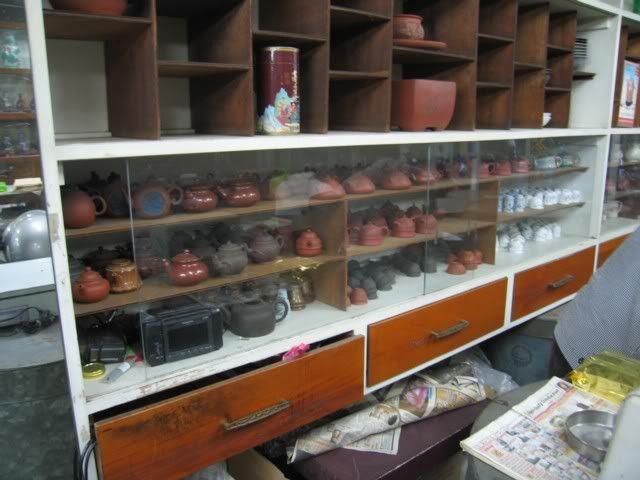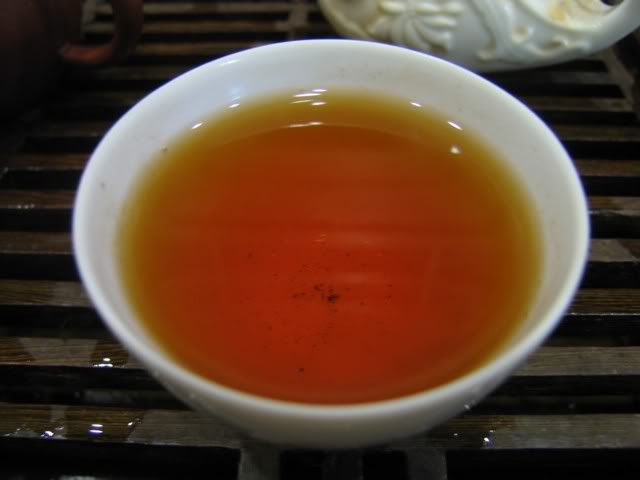I had some extra time today, so I went back to the same tea shop that I visited last weekend today. Specifically, that was the one with the big tea canisters (picture in the bottom of the post) and where I picked up a few aged oolongs.
I wanted to get some of the tieguanyin which was so good, and hopefully, to find more stuff there that’s hidden in those big canisters.
The laobanniang (literally owner’s wife, or female owner, of a shop) was pretty happy to see me coming back, and when I asked for the tieguanyin, she promptly went to it. I also asked if she has other stuff — stuff that is more like this and less like the qizhong, which I told her is a bit too sour. She said there are lots of different stuff in her store, but she might need to spend some time looking for them. I think she could sense that if she finds anything good, I’ll be willing to buy them. I also venture to guess that she doesn’t sell much of this stuff normally.
Now, to give you an idea of what we’re talking about…. this is a closeup of one of those tea cans. This is the smaller sized ones (the ones you see lining up on the left in the last entry about this shop)

On one can it says “Pu’er Cha”, the other “Ridong Hongcha”, a type of Japanese red (black) tea (here’s a link to Nittoh Black Tea, their proper name). What’s in the can has nothing to do with the words on them, and this is true for pretty much all of them in the store — about 4-5 dozens of them.
Inside each of them are bags

Like this (this is a picture of one of the bigger cans on the right hand side). In each of these bags are kilos of tea — some more, some less. The little slip of paper indicates what it is, and how much it should be. Some of these bags probably haven’t been opened for years, and I suspect many of them are simply leftovers from stock they had years ago — half a kilo here, two kilos there, etc. Tea that is valuable enough to keep, but after a certain time passes, not easy to sell. How do you tell a regular customer that you have some three year old oolong you can sell them? They’d think you’re a crook. So in the bags they sit. Year in, year out, and the older bags probably sink to the bottom. The opened bag is the one with the tieguanyin that I want. The other two unopened bags? Other kinds of aged oolongs that I haven’t even tried. She opened one bag for me and got me a sample. The piece of paper says “ROC Year 77 (1988), Spring, 2400”, 2400 being the price of the tea. It’s a lightly rolled oolong. Not sure exactly what it is, but it sure looks old and doesn’t smell sour. Let’s hope it’s good. If I could, I’d spend a whole day at the store, opening each can, and looking through them, trying teas. I’ll be like a little kid.
She said she will prepare some more samples for me when I go next time. I told her I’d like to try anything she has and decide what I want. I know that other than Taiwan, buying aged oolongs is difficult, and so I should take advantage of the fact that I’m here to snap up enough for at least a year or two’s worth of consumption.
Not only do they have old tea… they also have old neglected teaware

Too bad teapots don’t age the way teas do. Most of the teapots are pretty mediocre anyway.
So…. I made off with some of the tieguanyin, and two samples. One’s that 1988 tea, the other is also an old tea that was recently re-roasted. I want to compare them and see. I think, though, that given what I’ve tried so far, I prefer stuff that haven’t been re-roasted.












Yeah whisky prices have been leaking too, as well as luxury watches. I wrote a post maybe a decade ago…